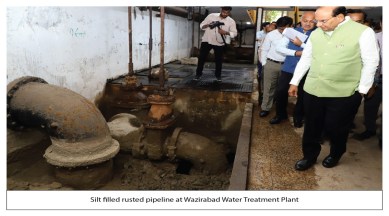Stay updated with the latest - Click here to follow us on Instagram
L-G flags ‘miserable’ state of water treatment plant, Saurabh hits back
Delhi L-G flags ‘miserable’ state of water treatment plant, AAP’s Saurabh Bharadwaj hits back

Amid disruptions in water supply in the city over the past week, the L-G and the Delhi government are at loggerheads over the quality of water being supplied to citizens.
The latest flashpoint was triggered after L-G VK Saxena wrote to Chief Minister Arvind Kejriwal expressing “deep distress” on the state of the Wazirabad water treatment plant (WTP) and feeder pondage area at Wazirabad Barrage, that feeds the Wazirabad and Chandrawal WTPs, following a visit earlier this week. Seeking the CM’s “urgent intervention”, the L-G said the “miserable hygiene and sanitary conditions” at Wazirabad WTP, which supplies drinking water to large parts of the city, has an impact on its quality.
Responding to the L-G, Water Minister Saurabh Bhardwaj accused him of “playing dirty politics” and asked him to take cognizance of illegal sand mining in Haryana which, he argued, had been blocking supply of Yamuna water towards Delhi while Haryana was “releasing industrial wastewater towards Delhi”.
The L-G alleged that frequent water shortage in the city was on account of the Wazirabad and Chandrawal WTPs not being fully operational and not due to the “Haryana excuses that AAP makes to fool people”.
“On a visit to the area on 09.03.2023, with the purpose of inspection emanating out of the mandate of the High-Level Committee constituted by the Hon’ble NGT, that I chair, for cleaning of the Yamuna, I happened to chance upon grave dereliction and criminal neglect of the WTP and pondage area, which, as it turned out, is resulting in totally avoidable water shortage,” Saxena wrote.
“What kind of water is being supplied to people of Delhi? What is its quality and is it potable? Aren’t we playing with the health and life of people of Delhi by supplying them contaminated water? Is this justified in the National Capital of the country? Can Delhi afford to lose out on 9,12,500 million gallons of water only because DJB did not desilt/clean its storage ponds?” he asked.
Stating that the plant itself was “marred by rusted and trash-ridden reservoirs, corroded pipelines, silt-covered equipment and power guzzling water pumps”, the L-G said that “such negligence” in ensuring water supply to the residents of Delhi “is inexcusable”. Saxena also flagged “gross inaction” by the Delhi Jal Board in cleaning and desilting the pond reservoir and alleged that desilting was not done despite a contract for the service being in place since 2013. This, he claimed, has resulted in the depth of the pond reducing from 4.26 metres to 0.42 metres in the last 8 years.
According to Saxena, work of desilting was stopped due to an NGT stay order in September 2014 and was restarted after the stay was lifted in 2015 after which, in about 9 months during 2013-14, 5 lakh cubic metres of silt was removed; between 2015 and 2018, however, only 1.1 cubic metres of silt was removed.
“In addition to this, natural siltation also kept taking place and progressively led to further shrinking of the pond, thereby proportionately reducing Delhi’s capacity to hold and store water…,” he added.
Bharadwaj said he had visited the Wazirabad WTP and pond recently and seen reduced level of water. To achieve full production from Wazirabad and Chandrawal WTPs, he argued, the Wazirabad pond level should be 674.5 feet but over the last few weeks, it had touched the bottom-level of the pond at 671.4 feet adversely affecting production of WTPs at Chandrawal and Wazirabad.
“Latest production of Chandrawal is 90 MGD against normal production of 100 MGD while Wazirabad is producing 90 MGD against usual production of 135 MGD. This has impacted water supply all over Delhi as raw water is being diverted from other shares of WTPs like Haiderpur, Dwarka, Nangloi and Okhla. The water which is accumulated in Wazirabad pond is nothing but industrial waste from Haryana drains,” he stated.
“Wazirabad and Chandrawal WTPs have been receiving contaminated water for the past many years due to which mechanical equipment is getting corroded frequently,” he added.
Earlier this week, the Haryana government had denied Bharadwaj’s allegation on illegal sand mining and said: “Haryana is not obstructing any natural river flow and is providing pollution-free canal water to Delhi, more than its legitimate entitlement.”